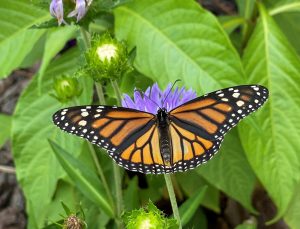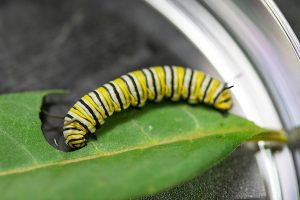Milkweed: we all know it as the poster plant for pollinator gardens, but did you know it feeds many other insects beyond the beloved monarch butterfly? The Sunshine State is home to over 20 species of native milkweed in the Asclepias genus. A few are endemic. This means they are ONLY found in this state and nowhere else in the world. How incredible is that!?

The monarch gets all the press, but queen and soldier butterflies also use these native milkweeds as larval host plants for their caterpillars. Many other butterflies (pipevine, spicebush and eastern swallowtail) and bees, (native sweat bees, leafcutter bees and yellow-faced bees) rely on these starry little flowers for pollen and nectar.
It may surprise you to learn in the last several months there has been a bit of debate surrounding milkweed and whether we should be including it in our pollinator gardens at all!
I recently attended a webinar entitled “Milkweed, Monarchs, and OE in Florida: It’s Complicated” with Dr. Jaret Daniels. He is the curator of the Florida Museum of Natural History’s McGuire Center for Lepidoptera and Biodiversity. You can find a recording of the presentation here. In it Dr. Daniels gives the latest science-based information and explains the impact of OE disease on the monarch populations. Plus, he offers advice on what to do with milkweed in the Florida landscape.
So, for now, back to the monarch and milkweed conundrum. There’s so much information that this could go on for pages and pages. However, due to the limited space here, I will concentrate on

A few essential points you ought to be aware of:
- There is a notable decline in monarch populations over the last 20-30 years. This has been the driver of much scientific research, but it is a very complex topic and there are still a lot of data gaps.
- OE (Ophryocystis elektroscirrha) is a protozoan parasite that begins its life cycle as inactive spores on plants waiting to be eaten by a larva. Once consumed, it multiples within the larva and produces new spores on the butterfly’s scales when it emerges. When the levels of OE multiply and get too high, it impacts the fitness and survivability of the butterfly.
- Warming temperatures, loss of habitat, and the prevalence of non-native tropical milkweed, Asclepias curassavica, contribute to heavier OE loads, increase in OE infection, OE transmission and local population loss.
What we can do:

- Plant only native milkweeds. A. tuberosa, A. incarnata and A. perennis are three of the most commonly cultivated natives. If you have tropical milkweed north of Lake Okeechobee keep cut it back to the ground, forcing dormancy from of October-February. Alternatively, consider replacing it with native species. To keep it from spreading into wild areas out of your control, remove and dispose of seed pods before they ripen and disperse.
- Avoid pesticide treated plants.
- Enjoy butterflies in the wild. Don’t rear monarchs indoors. There is no significant evidence that rearing monarchs

Monarch butterfly caterpillar feeding on a leaf in captivity. Photo: Tyler Jones, UF/IFAS benefits their conservation and it can have negative impacts on disease transmittal, inbreeding, ability of monarchs to orient south for migration as well as physical fitness and overall health of the butterflies.
- Be aware that milkweeds get their common name from the toxic milky sap they exude. This sap can irritate skin and is toxic if consumed in large quantities. Keep pets and small children away.
Overall, much is still unknown about the decline of monarch butterflies and the influence of human actions on their population.
As more information becomes available, recommendations may be subject to change. For now, plant and enjoy native milkweeds in your yard. The various insects that rely on these plants will be grateful! For more information on Florida milkweeds, please see Gardening Solutions. For a full list of plants that are attractive to a number of butterfly species, utilize the free Florida-Friendly Landscaping Butterfly Gardens app.
 7
7
